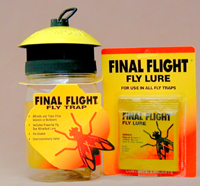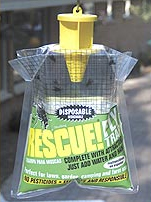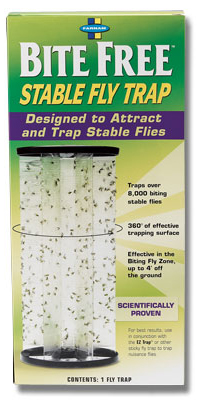Lures for Fly Traps
Rincon-Vitova offers a variety of fly traps and lures. Fly traps catch the adult stage of the house fly and other filth breeding flies in an integrated pest management (IPM) program. Our fly parasites attack the pupa stage, then predators, like hister beetle, attack the larva stage and manure management will reduce the egg stage. There are fly traps that attract house flies and others to attract biting flies. You many need some of each depending on your particular situation.
see biting fly traps
One quart volume contains 30,000 flies so larger volume traps will be able to trap more flies before they need to be emptied. A lot of small traps can be used to deal with a large number of flies.
Here are some of our more popular traps
Final Flight Fly Trap by Troy Biosciences is our most popular trap. It is a reusable plastic quart jar that comes with a packet of lure and holds 5,000 dead flies. The durable top screws on to the jar. The jar and top are easy to empty and clean, generally every 1-2 weeks. Fly traps like this with smelly bait are best placed outdoors in an area with good light, not too windy, at a height of 2-5 feet off the ground where the powerful attractant and odor attracts flies.

Final Flight Fly Lures use a fly sex attractant plus feeding stimulants to be mixed with water in the jar. The liquid bait draws flies through openings in the lid of the trap and into the liquid in the jar. Use these along our fly parasitic wasps for safe and effective non-toxic fly control.
more information Final Flight Fly Traps
Jumbo Bag Fly Traps (FTJB) Traps house, false stable blow, blue bottle, green bottle, flesh, face flies, etc. Use where you need fast, short term control. Not our first choice because they are disposable and not biodegradable, but sometimes we appreciate them for fast, short-term, high-capacity control in bad situations when frequent trap cleaning and bait mixing are impractical.
Big Bag Fly Traps (FTBB) are not our first choice because they are disposable and not biodegradable, but sometimes we appreciate them for fast, short-term, high-capacity control in bad situations when we aren’t able to mix bait or regularly empty jars full of dead flies. The traps work well - we have gotten good feedback on them from our customers.

Farnam Bite Free Stable Fly Trap (FTBFS) Bite Free Stable Fly Traps contain no insecticides and are economical and easy to use. Traps hold more flies than other sticky traps with no fly trap odor. Compact size offers a 360° trapping surface that holds several thousand flies. When the trap is full just throw it away. Fly Traps have a special weatherproof adhesive that won’t melt or wash away. Ideal for use around stables, cattle ranches, poultry operations, kennels, restaurants, home and garden. Good design, disposable trap that can be used when you have short term problems with biting flies. For longer term control see Biting Fly Traps. For more information on Bite Free trap

Farnum StarBar Fly Attractant (FLYATT) is another good fly lure with strong-smelling feeding stimulants and sex attractants. It can be used in any fly trap including Sagebrush metal fly traps and homemade traps. Each pack contains 8 attractant pouches. Use 2 pouches per gallon; replace after 30 days.
No-Gag-Me Lure (FTLURNO3) Effective bait made of food grade materials. Mix with water in a bait tray or jug-style trap to attract flies, but not repel people. Mild odor until fermentation occurs (2 weeks).
Molasses (DIY) diluted 1:3 with water can be as effective as the commercial baits described and may be used in combination with the commercial pheromone and food baits in any fly trap. This makes a bait that is pleasant to people in contrast to baits that smell putrid.
Interesting Publications
Predicting and Controlling Stable Flies on California Dairies, 2007 Free
Powerpoint presentations to Defense Department pest control services
Some interesting presentations on filth fly traps and lures
type Control F, find "filth fly"
http://www.afpmb.org/meetings/TriService2007/2007proceedings.htm
Fly Baits and Lures
Fly Bait Notes
Bait fly traps with apple cider vinegar or wine to catch fruit flies – also known as vinegar flies.
A good bait for house flies is 1 part molasses, 3 parts water. This ferments and smells pleasant as long as it doesnt putrify.
Many house fly baits use brewers yeast, fish meal, and sugar that ferments in water.
High protein feed, meat scraps or manure can be put in a trap with water and the putrifying material will draw flies.
To keep flies from breeding in the bait, put a piece of fly screen or nylon netting over the bucket, before placing a Sagebrush trap over the bucket, so keep the flies away from the bait.
Fly Bait Recipes - From School IPM website http://schoolipm.ifas.ufl.edu/tp14.htm
* Liquid bait, either the Yeast Bait or the Beltsville Bait, is a superior attractant that will not breed flies unless it is allowed to dry to a sludge. If either of these baits contaminate clothing and hands, use baking soda and water to remove the odors.
* Yeast Bait has a foul odor that is particularly attractive to female flies because it smells like a good place to lay eggs. This bait will lure flies even from the most attractive breeding sites.
* Beltsville Bait will attract male flies as well as females because it contains sugar. This sweet bait can be used in cool weather when the main aim of trapping is to reduce the total number of flies rather than to suppress breeding.
* Baits such as decaying meat or fish scraps will attract mainly blow flies and flesh flies. These baits should always be put inside a rolled down plastic bag and then placed in the bait pan. Periodically check the bait so that it does not become a breeding site for flies. The larvae feeding on the bait can crawl out of the plastic bag and away from the trap to pupate. If larvae are found in the bait, the plastic bag should be sealed, thrown away, and replaced with a new bag and bait.
* Sex pheromone baits for flies do not last long and do not attract flies from a distance. They are likely to be more expensive and less effective than other food-type baits which can be mixed from common materials and attract both sexes.
* Do not add poison to the bait. Flies are more attracted to the live flies in the trap than they are to dead ones.
* The top edge of the bait pan must be at least 1/2 inch above the bottom edge of the trap. If flies can sit on the top edge of the bait pan and look out under the trap, trap catches will be poor.
See also
Catalog of Fly Control in pdf
|

